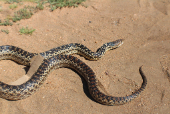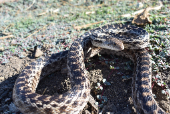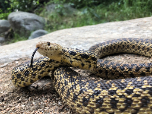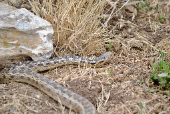San Diego Gopher Snake (Pituophis catenifer annectens)
Description: Adults of the species Pituophis catenifer can be 2.5 to 9 feet long. Hatchlings are fairly long, generally around 15 inches in length. Most adults of this subspecies, Pituophis catenifer annectens, are 4 to 5 ft. long. A large snake with heavily keeled scales, a narrow head that is slightly wider than the neck, and a protruding rostral scale on the tip of the snout that is bluntly rounded. Ground color is tan, light brown or yellowish, with large brown or blackish rounded blotches along the back and smaller markings on the sides. The dorsal blotches can fuse together producing a very dark color. The underside is cream to yellow with dark spots. The back of the neck is often a dull orange. There is usually a dark stripe across the head in front of the eyes and a dark stripe from behind each eye to the angle of the jaw. Juveniles tend to have a darker and more compact pattern than adults.
Habitat: Found in a variety of habitats - grassland, coastal sage scrub, agricultural lands, riparian areas, woodlands, and desert, from sea level to the mountains. Especially common in coastal areas.
Range: This subspecies occurs in southern California - south of the range of P. c. catenifer on the south coast from Monterey County south on the inland side of the mountain ranges to Baja California. It also occurs on Santa Catalina Island. It is sympatric with P. c. affinis in a narrow range, but no intergrades have been found. It apparently intergrades with P. c. catenifer, and P. c. deserticola.
Found in these States:
CA
Diet: Eats mostly small mammals, especially pocket gophers, moles, rabbits, and mice, along with birds and their eggs and nestlings. Occasionally eats lizards and insects. A powerful constrictor; kills prey by suffocating them in body coils or by pressing the animal against the walls of their underground burrows.
Reproduction: Mating occurs in spring after emergence from winter hibernation. Mating and egg laying occurs later at higher elevations in the mountains. Females are oviparous, laying one to 2 clutches of 2 to 24 eggs from June to August. Eggs hatch in 2 to 2.5 months.
Status: Listed as Least Concern in view of the large and relatively stable extent of occurrence, area of occupancy, number of subpopulations, and population size. No major threats exist.
»» Kingdom: Animalia - Animals
»» Phylum: Chordata - Chordates
»» Subphylum: Vertebrata - Vertebrates
»» Class: Reptilia - Reptiles
»» Order: Squamata - Scaled Reptiles
»» Suborder: Serpentes
»» Superfamily: Colubroidea
»» Family: Colubridae - Colubrids
»» Genus: Pituophis
»» Species: Pituophis catenifer - Gopher Snakes
»» Subspecies: Pituophis catenifer annectens - San Diego Gopher Snake
This article uses material from the Wikipedia article "Pituophis catenifer", which is released under the Creative Commons Attribution-Share-Alike License 3.0. Content may have been omitted from the original, but no content has been changed or extended.
|













